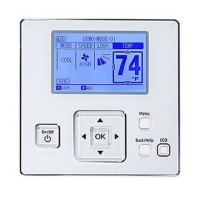4
P5415484
● During the test run, check the unit’s operation temperature. If the unit is used in an environment where the
temperature exceeds the operation boundary, it may cause severe damage. Check the operation temperature
boundary in the manual. If there is no specifi ed temperature, use the unit within the operation temperature
boundary of 35° to 104°F (0 to 40°C).
● Read this installation and maintenance manual for proper electrical wiring work.
Installation Precautions
Take the following precautions to reduce the risk of electric shock, fi re or explosion
resulting in serious injury or death:
● If the remote sensors are not used with this controller, then do not install this controller…
▫ In a room where there is no thermostat.
▫ Where the unit is exposed to direct sunshine or direct light.
▫ Where the unit is in close proximity to a heat source.
▫ Where hot/cold air from the outdoors, or a draft from elsewhere (such as air vents, diffusers or grilles) can
affect air circulation.
▫ In areas with poor air circulation and ventilation.
● Perform a test run using the controller to ensure normal operation. Safety guards, shields, barriers, covers, and
protective devices must be in place while the compressor/unit is operating. During the test run, keep fi ngers and
clothing away from any moving parts.
After installation work for the system has been completed, explain the “Safety Precautions,” use, and maintenance
of the unit to the customer according to the information in all manuals that accompanied the system. All manuals and
warranty information must be given to the user or left near the Indoor Unit.
Electrical Precautions
Take the following precautions to reduce the risk of electric shock, fi re or explosion
resulting in serious injury or death:
● Only use electrical protection equipment and tools suited for this installation.
● Insulate the wired controller against moisture and temperature extremes.
● Use specifi ed cables between units and the controller.
● Communication cabling must be a minimum of 18-Gauge, 2-Conductor, Stranded Copper.
Shielded cable must be considered for applications and routing in areas of high EMI and other sources of
potentially excessive electrical noise to reduce the potential for communication errors. When shielded cabling
is applied, proper bonding and termination of the cable shield is required as per Johnson Controls guidelines.
Plenum and riser ratings for communication cables must be considered per application and local code
requirements.
● The polarity of the input terminals is important, so be sure to match the polarity when using contacts that have
polarity.
● Highly dangerous electrical voltages may be used in this system. Carefully refer to the wiring diagram and these
instructions when wiring. Improper connections and inadequate grounding can cause serious injury or death.
● Before installing the controller or remote devices, ensure that the indoor and outdoor unit operation has been
stopped. Further, be sure to wait at least fi ve minutes before turning off the main power switch to the indoor or
outdoor units. Otherwise, water leakage or electrical breakdown may result.
● Do not open the service cover or access panel to the indoor or outdoor units without turning OFF the main
power supply. Before connecting or servicing the controller or cables to indoor or outdoor units, open and tag all
disconnect switches. Never assume electrical power is disconnected. Verify with a meter and equipment.
● Use an exclusive power supply at the controller’s rated voltage.
● Be sure to install circuit breakers (ground fault interrupter, isolating switch, molded case circuit breaker, and so
forth) with the specifi ed capacity. Ensure that the wiring terminals are tightened securely to recommended torque
specifi cations.
● Clamp electrical wires securely with a cord clamp after all wiring is connected to the terminal block.
In addition, run wires securely through the wiring access channel.
● When installing the power lines, do not apply tension to the cables. Secure the suspended cables at regular
intervals, but not too tightly.
● Make sure that the terminals do not come into contact with the surface of the electrical box.
If the terminals are too close to the surface, it may lead to failures at the terminal connection.

